Report: Organisational Behaviour at IKEA - Analysis and Impact
VerifiedAdded on 2020/07/23
|17
|5071
|87
Report
AI Summary
This report provides a comprehensive analysis of organisational behaviour within IKEA. It begins by exploring the impact of organisational culture, politics, and power dynamics on team behaviour, emphasizing the importance of a collaborative culture and the effects of positive and negative workplace politics. The report then delves into motivational theories, including intrinsic and extrinsic motivation, with a focus on Maslow's hierarchy of needs and equity theory, and how IKEA can apply these to enhance employee productivity and satisfaction. Furthermore, the report examines ways to create effective teams, discusses different philosophies and models that influence team development, and concludes by highlighting the practical implications of these concepts for IKEA's operations and overall success. The report underscores the critical role of organisational behaviour in maximizing employee output and achieving corporate objectives.
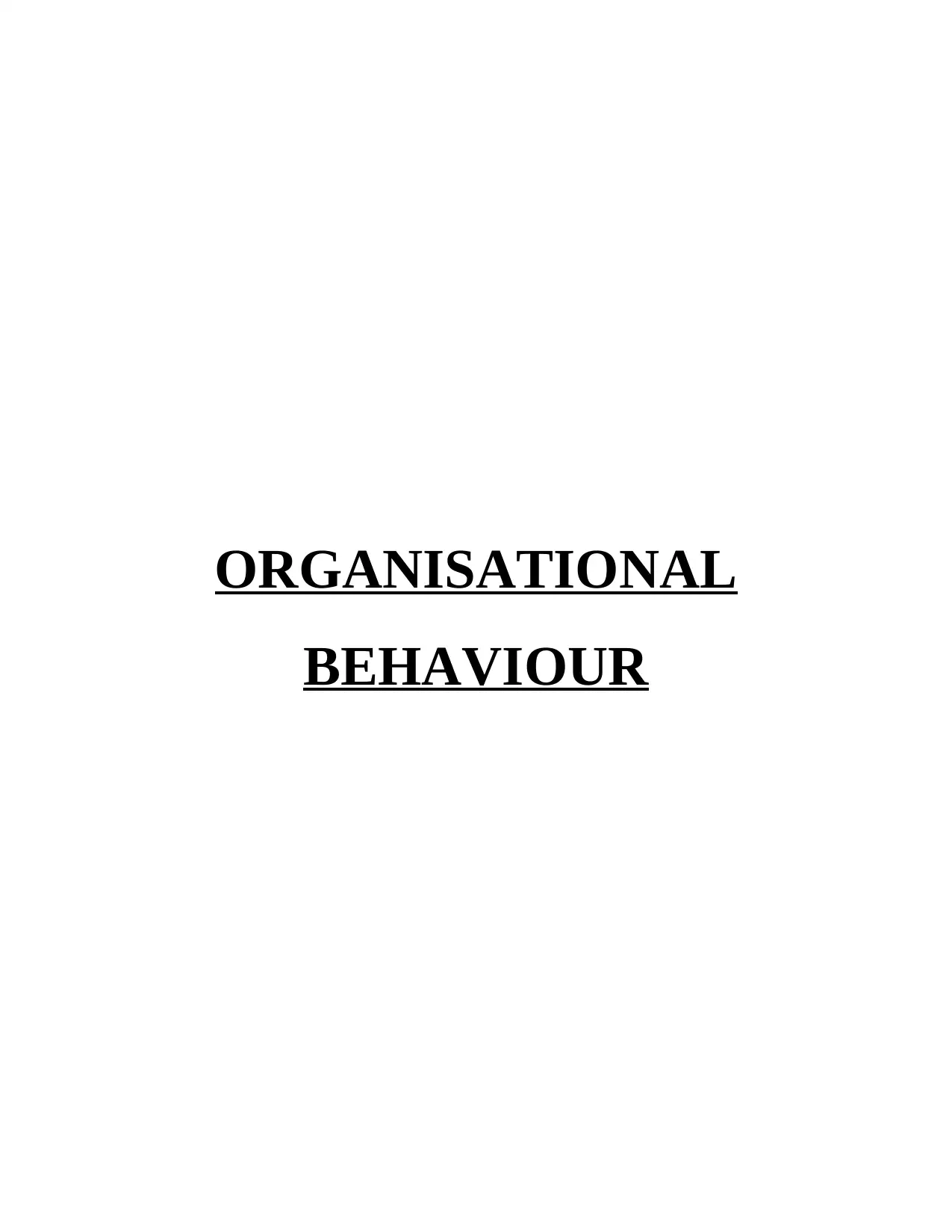
ORGANISATIONAL
BEHAVIOUR
BEHAVIOUR
Paraphrase This Document
Need a fresh take? Get an instant paraphrase of this document with our AI Paraphraser
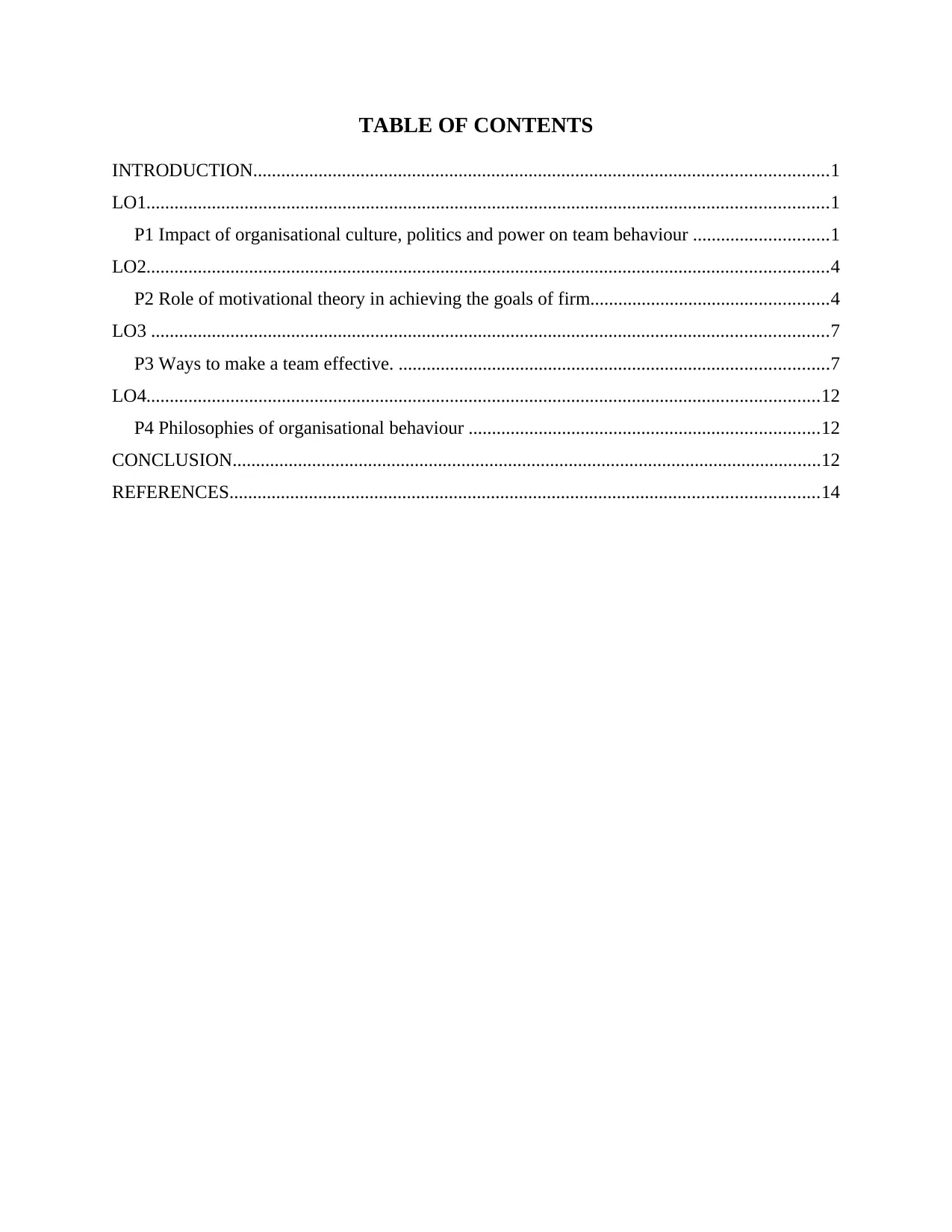
TABLE OF CONTENTS
INTRODUCTION...........................................................................................................................1
LO1..................................................................................................................................................1
P1 Impact of organisational culture, politics and power on team behaviour .............................1
LO2..................................................................................................................................................4
P2 Role of motivational theory in achieving the goals of firm...................................................4
LO3 .................................................................................................................................................7
P3 Ways to make a team effective. ............................................................................................7
LO4................................................................................................................................................12
P4 Philosophies of organisational behaviour ...........................................................................12
CONCLUSION..............................................................................................................................12
REFERENCES..............................................................................................................................14
INTRODUCTION...........................................................................................................................1
LO1..................................................................................................................................................1
P1 Impact of organisational culture, politics and power on team behaviour .............................1
LO2..................................................................................................................................................4
P2 Role of motivational theory in achieving the goals of firm...................................................4
LO3 .................................................................................................................................................7
P3 Ways to make a team effective. ............................................................................................7
LO4................................................................................................................................................12
P4 Philosophies of organisational behaviour ...........................................................................12
CONCLUSION..............................................................................................................................12
REFERENCES..............................................................................................................................14
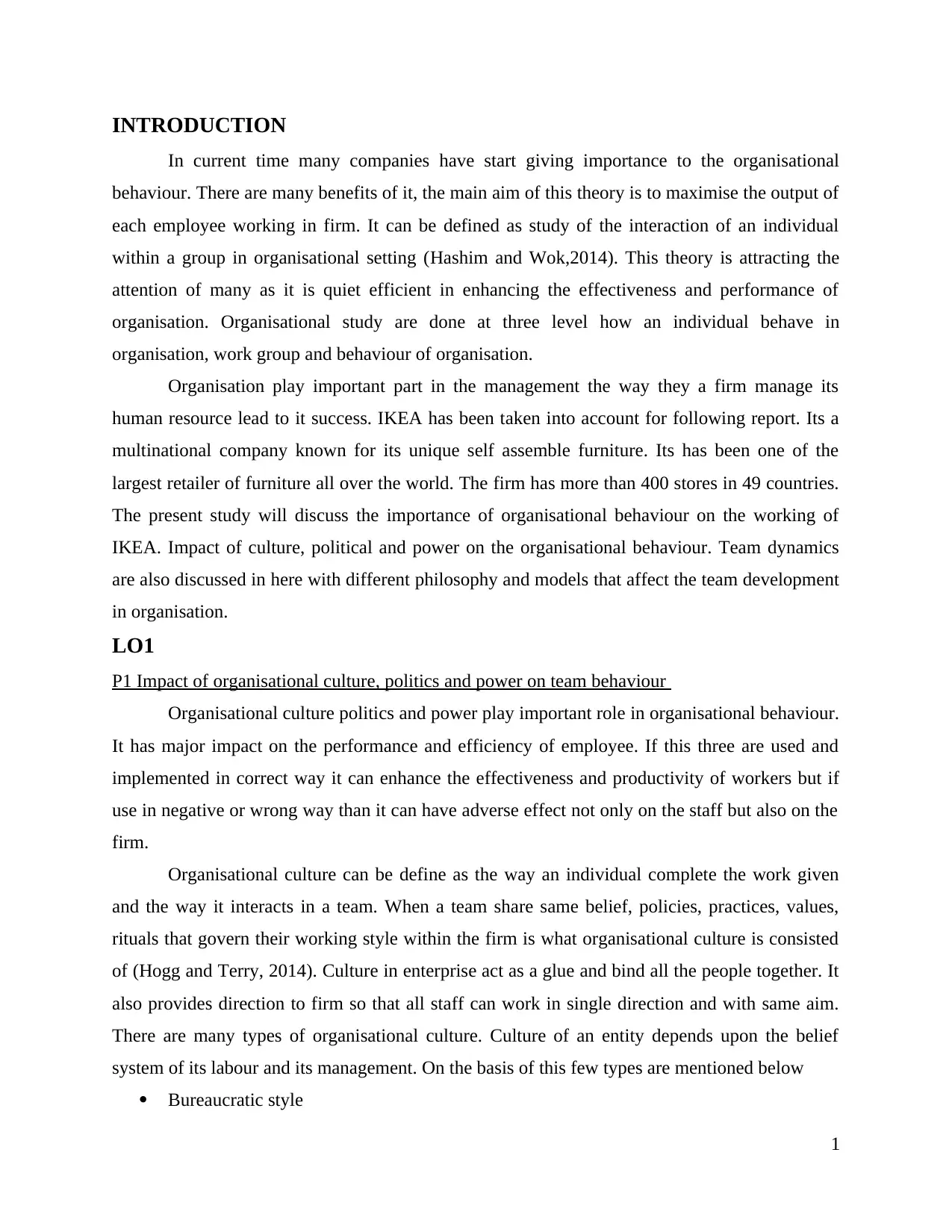
INTRODUCTION
In current time many companies have start giving importance to the organisational
behaviour. There are many benefits of it, the main aim of this theory is to maximise the output of
each employee working in firm. It can be defined as study of the interaction of an individual
within a group in organisational setting (Hashim and Wok,2014). This theory is attracting the
attention of many as it is quiet efficient in enhancing the effectiveness and performance of
organisation. Organisational study are done at three level how an individual behave in
organisation, work group and behaviour of organisation.
Organisation play important part in the management the way they a firm manage its
human resource lead to it success. IKEA has been taken into account for following report. Its a
multinational company known for its unique self assemble furniture. Its has been one of the
largest retailer of furniture all over the world. The firm has more than 400 stores in 49 countries.
The present study will discuss the importance of organisational behaviour on the working of
IKEA. Impact of culture, political and power on the organisational behaviour. Team dynamics
are also discussed in here with different philosophy and models that affect the team development
in organisation.
LO1
P1 Impact of organisational culture, politics and power on team behaviour
Organisational culture politics and power play important role in organisational behaviour.
It has major impact on the performance and efficiency of employee. If this three are used and
implemented in correct way it can enhance the effectiveness and productivity of workers but if
use in negative or wrong way than it can have adverse effect not only on the staff but also on the
firm.
Organisational culture can be define as the way an individual complete the work given
and the way it interacts in a team. When a team share same belief, policies, practices, values,
rituals that govern their working style within the firm is what organisational culture is consisted
of (Hogg and Terry, 2014). Culture in enterprise act as a glue and bind all the people together. It
also provides direction to firm so that all staff can work in single direction and with same aim.
There are many types of organisational culture. Culture of an entity depends upon the belief
system of its labour and its management. On the basis of this few types are mentioned below
Bureaucratic style
1
In current time many companies have start giving importance to the organisational
behaviour. There are many benefits of it, the main aim of this theory is to maximise the output of
each employee working in firm. It can be defined as study of the interaction of an individual
within a group in organisational setting (Hashim and Wok,2014). This theory is attracting the
attention of many as it is quiet efficient in enhancing the effectiveness and performance of
organisation. Organisational study are done at three level how an individual behave in
organisation, work group and behaviour of organisation.
Organisation play important part in the management the way they a firm manage its
human resource lead to it success. IKEA has been taken into account for following report. Its a
multinational company known for its unique self assemble furniture. Its has been one of the
largest retailer of furniture all over the world. The firm has more than 400 stores in 49 countries.
The present study will discuss the importance of organisational behaviour on the working of
IKEA. Impact of culture, political and power on the organisational behaviour. Team dynamics
are also discussed in here with different philosophy and models that affect the team development
in organisation.
LO1
P1 Impact of organisational culture, politics and power on team behaviour
Organisational culture politics and power play important role in organisational behaviour.
It has major impact on the performance and efficiency of employee. If this three are used and
implemented in correct way it can enhance the effectiveness and productivity of workers but if
use in negative or wrong way than it can have adverse effect not only on the staff but also on the
firm.
Organisational culture can be define as the way an individual complete the work given
and the way it interacts in a team. When a team share same belief, policies, practices, values,
rituals that govern their working style within the firm is what organisational culture is consisted
of (Hogg and Terry, 2014). Culture in enterprise act as a glue and bind all the people together. It
also provides direction to firm so that all staff can work in single direction and with same aim.
There are many types of organisational culture. Culture of an entity depends upon the belief
system of its labour and its management. On the basis of this few types are mentioned below
Bureaucratic style
1
⊘ This is a preview!⊘
Do you want full access?
Subscribe today to unlock all pages.

Trusted by 1+ million students worldwide
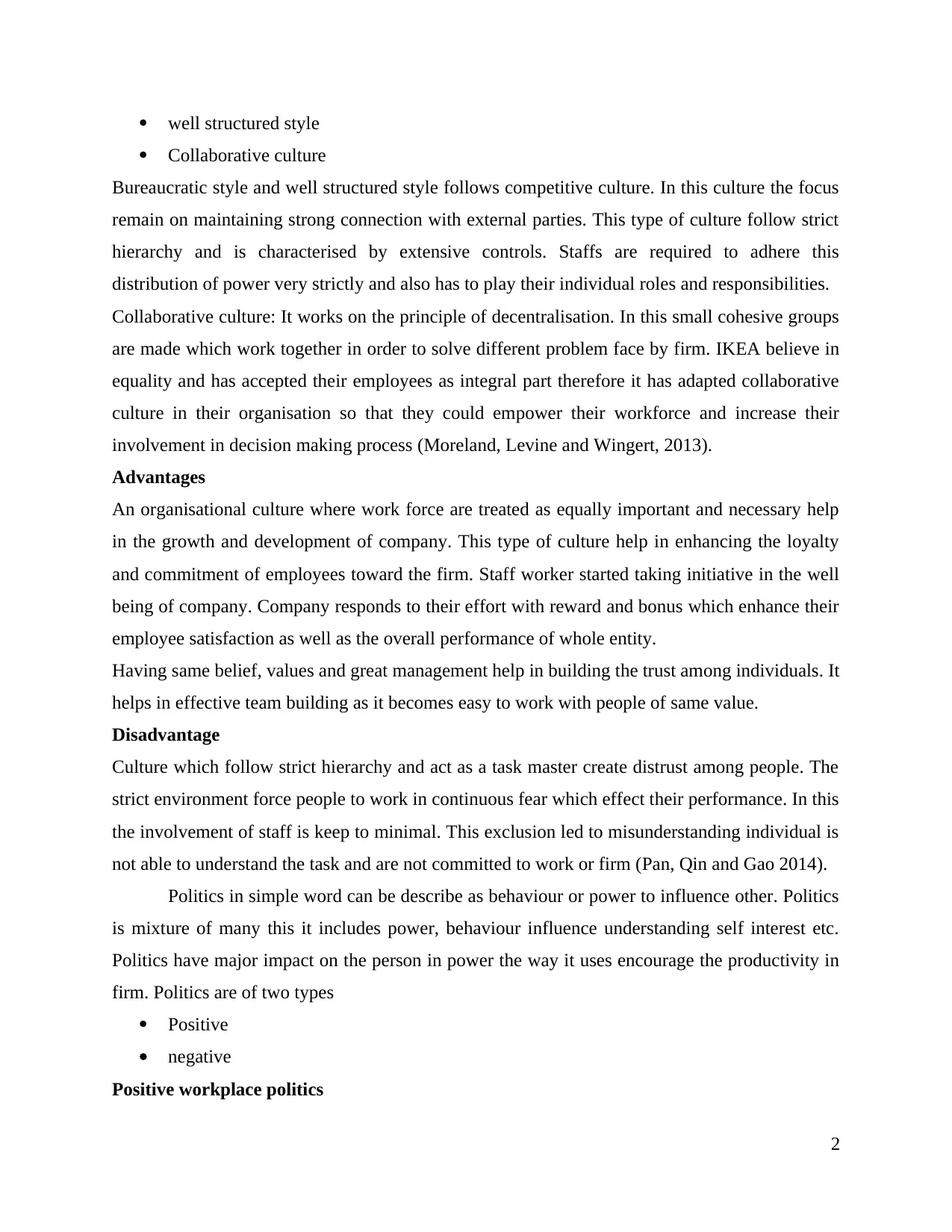
well structured style
Collaborative culture
Bureaucratic style and well structured style follows competitive culture. In this culture the focus
remain on maintaining strong connection with external parties. This type of culture follow strict
hierarchy and is characterised by extensive controls. Staffs are required to adhere this
distribution of power very strictly and also has to play their individual roles and responsibilities.
Collaborative culture: It works on the principle of decentralisation. In this small cohesive groups
are made which work together in order to solve different problem face by firm. IKEA believe in
equality and has accepted their employees as integral part therefore it has adapted collaborative
culture in their organisation so that they could empower their workforce and increase their
involvement in decision making process (Moreland, Levine and Wingert, 2013).
Advantages
An organisational culture where work force are treated as equally important and necessary help
in the growth and development of company. This type of culture help in enhancing the loyalty
and commitment of employees toward the firm. Staff worker started taking initiative in the well
being of company. Company responds to their effort with reward and bonus which enhance their
employee satisfaction as well as the overall performance of whole entity.
Having same belief, values and great management help in building the trust among individuals. It
helps in effective team building as it becomes easy to work with people of same value.
Disadvantage
Culture which follow strict hierarchy and act as a task master create distrust among people. The
strict environment force people to work in continuous fear which effect their performance. In this
the involvement of staff is keep to minimal. This exclusion led to misunderstanding individual is
not able to understand the task and are not committed to work or firm (Pan, Qin and Gao 2014).
Politics in simple word can be describe as behaviour or power to influence other. Politics
is mixture of many this it includes power, behaviour influence understanding self interest etc.
Politics have major impact on the person in power the way it uses encourage the productivity in
firm. Politics are of two types
Positive
negative
Positive workplace politics
2
Collaborative culture
Bureaucratic style and well structured style follows competitive culture. In this culture the focus
remain on maintaining strong connection with external parties. This type of culture follow strict
hierarchy and is characterised by extensive controls. Staffs are required to adhere this
distribution of power very strictly and also has to play their individual roles and responsibilities.
Collaborative culture: It works on the principle of decentralisation. In this small cohesive groups
are made which work together in order to solve different problem face by firm. IKEA believe in
equality and has accepted their employees as integral part therefore it has adapted collaborative
culture in their organisation so that they could empower their workforce and increase their
involvement in decision making process (Moreland, Levine and Wingert, 2013).
Advantages
An organisational culture where work force are treated as equally important and necessary help
in the growth and development of company. This type of culture help in enhancing the loyalty
and commitment of employees toward the firm. Staff worker started taking initiative in the well
being of company. Company responds to their effort with reward and bonus which enhance their
employee satisfaction as well as the overall performance of whole entity.
Having same belief, values and great management help in building the trust among individuals. It
helps in effective team building as it becomes easy to work with people of same value.
Disadvantage
Culture which follow strict hierarchy and act as a task master create distrust among people. The
strict environment force people to work in continuous fear which effect their performance. In this
the involvement of staff is keep to minimal. This exclusion led to misunderstanding individual is
not able to understand the task and are not committed to work or firm (Pan, Qin and Gao 2014).
Politics in simple word can be describe as behaviour or power to influence other. Politics
is mixture of many this it includes power, behaviour influence understanding self interest etc.
Politics have major impact on the person in power the way it uses encourage the productivity in
firm. Politics are of two types
Positive
negative
Positive workplace politics
2
Paraphrase This Document
Need a fresh take? Get an instant paraphrase of this document with our AI Paraphraser
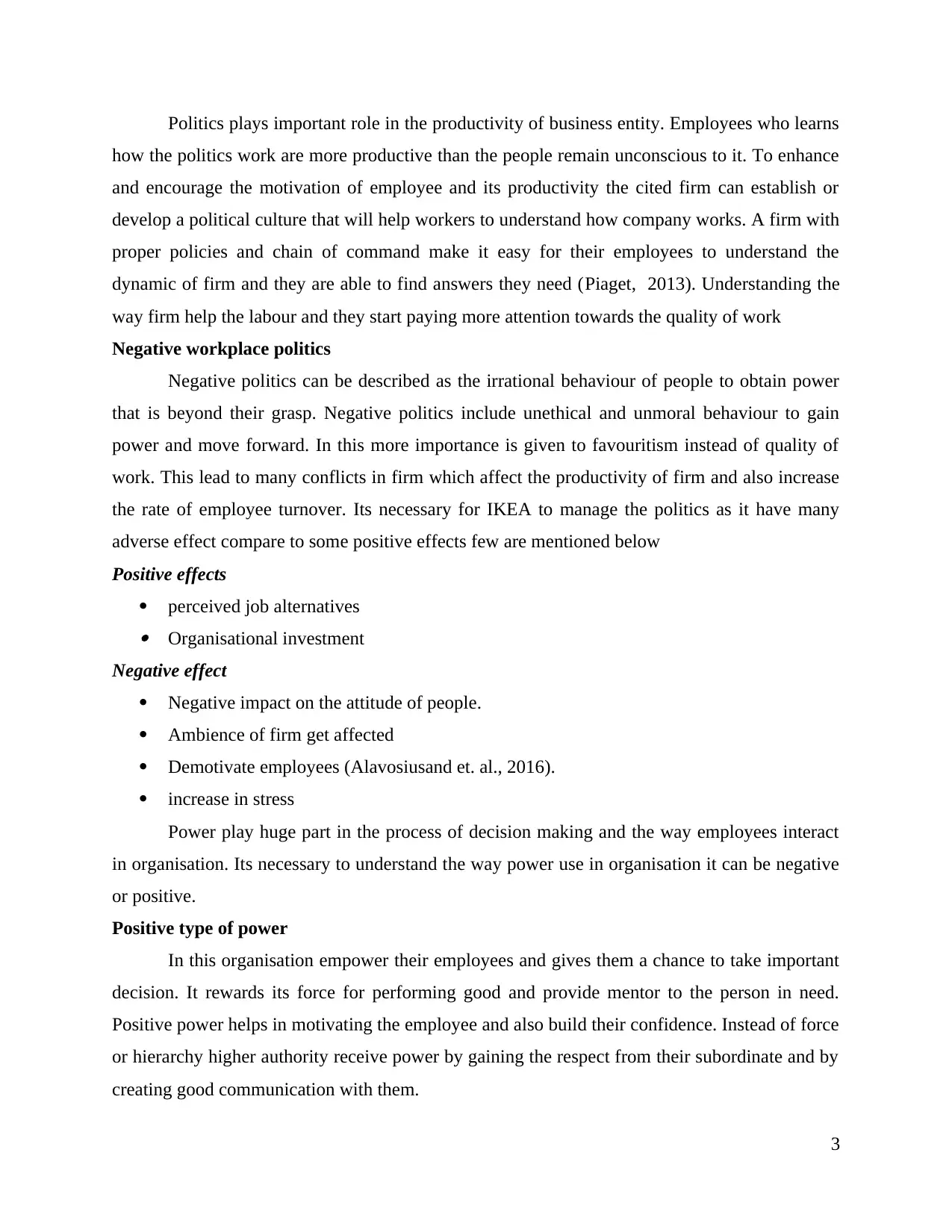
Politics plays important role in the productivity of business entity. Employees who learns
how the politics work are more productive than the people remain unconscious to it. To enhance
and encourage the motivation of employee and its productivity the cited firm can establish or
develop a political culture that will help workers to understand how company works. A firm with
proper policies and chain of command make it easy for their employees to understand the
dynamic of firm and they are able to find answers they need (Piaget, 2013). Understanding the
way firm help the labour and they start paying more attention towards the quality of work
Negative workplace politics
Negative politics can be described as the irrational behaviour of people to obtain power
that is beyond their grasp. Negative politics include unethical and unmoral behaviour to gain
power and move forward. In this more importance is given to favouritism instead of quality of
work. This lead to many conflicts in firm which affect the productivity of firm and also increase
the rate of employee turnover. Its necessary for IKEA to manage the politics as it have many
adverse effect compare to some positive effects few are mentioned below
Positive effects
perceived job alternatives Organisational investment
Negative effect
Negative impact on the attitude of people.
Ambience of firm get affected
Demotivate employees (Alavosiusand et. al., 2016).
increase in stress
Power play huge part in the process of decision making and the way employees interact
in organisation. Its necessary to understand the way power use in organisation it can be negative
or positive.
Positive type of power
In this organisation empower their employees and gives them a chance to take important
decision. It rewards its force for performing good and provide mentor to the person in need.
Positive power helps in motivating the employee and also build their confidence. Instead of force
or hierarchy higher authority receive power by gaining the respect from their subordinate and by
creating good communication with them.
3
how the politics work are more productive than the people remain unconscious to it. To enhance
and encourage the motivation of employee and its productivity the cited firm can establish or
develop a political culture that will help workers to understand how company works. A firm with
proper policies and chain of command make it easy for their employees to understand the
dynamic of firm and they are able to find answers they need (Piaget, 2013). Understanding the
way firm help the labour and they start paying more attention towards the quality of work
Negative workplace politics
Negative politics can be described as the irrational behaviour of people to obtain power
that is beyond their grasp. Negative politics include unethical and unmoral behaviour to gain
power and move forward. In this more importance is given to favouritism instead of quality of
work. This lead to many conflicts in firm which affect the productivity of firm and also increase
the rate of employee turnover. Its necessary for IKEA to manage the politics as it have many
adverse effect compare to some positive effects few are mentioned below
Positive effects
perceived job alternatives Organisational investment
Negative effect
Negative impact on the attitude of people.
Ambience of firm get affected
Demotivate employees (Alavosiusand et. al., 2016).
increase in stress
Power play huge part in the process of decision making and the way employees interact
in organisation. Its necessary to understand the way power use in organisation it can be negative
or positive.
Positive type of power
In this organisation empower their employees and gives them a chance to take important
decision. It rewards its force for performing good and provide mentor to the person in need.
Positive power helps in motivating the employee and also build their confidence. Instead of force
or hierarchy higher authority receive power by gaining the respect from their subordinate and by
creating good communication with them.
3
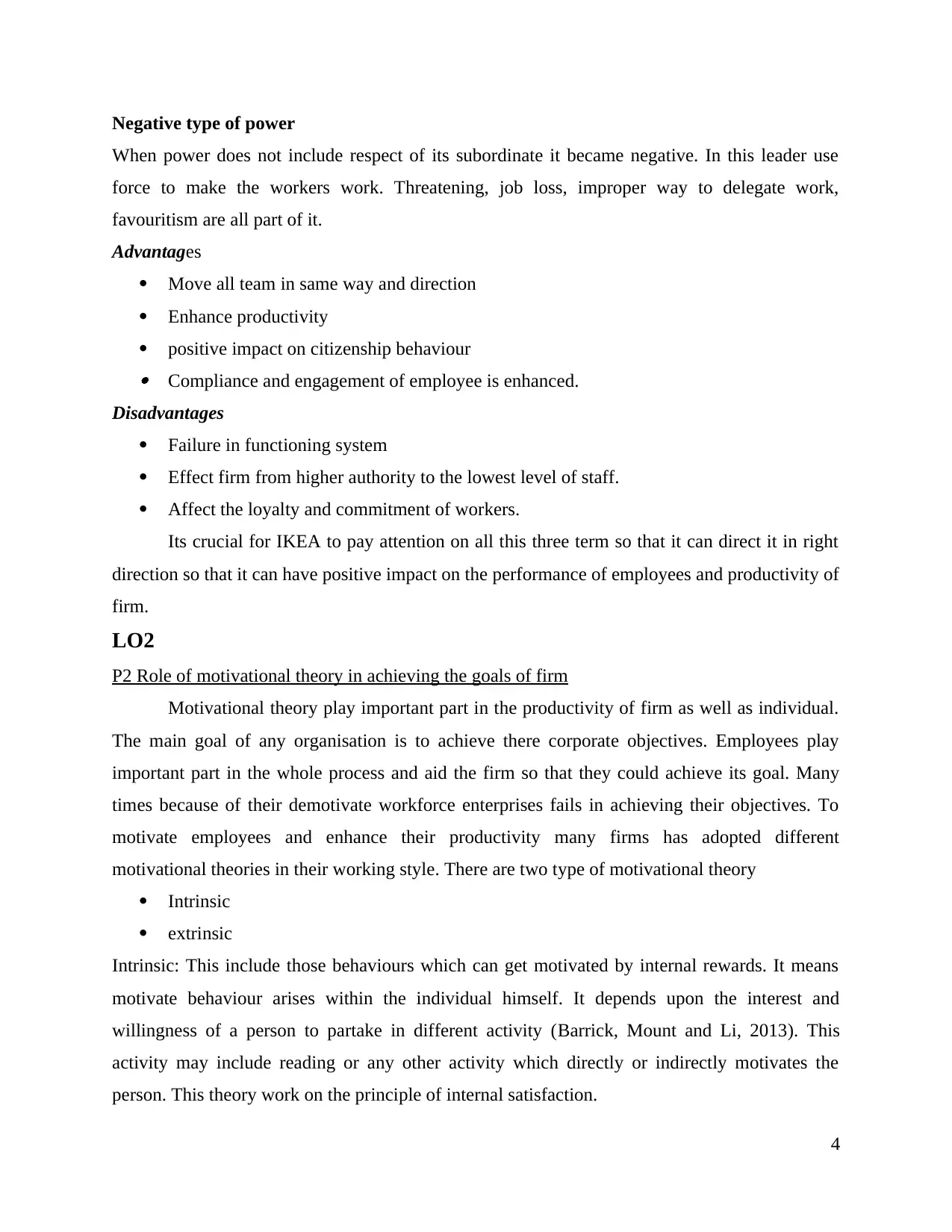
Negative type of power
When power does not include respect of its subordinate it became negative. In this leader use
force to make the workers work. Threatening, job loss, improper way to delegate work,
favouritism are all part of it.
Advantages
Move all team in same way and direction
Enhance productivity
positive impact on citizenship behaviour Compliance and engagement of employee is enhanced.
Disadvantages
Failure in functioning system
Effect firm from higher authority to the lowest level of staff.
Affect the loyalty and commitment of workers.
Its crucial for IKEA to pay attention on all this three term so that it can direct it in right
direction so that it can have positive impact on the performance of employees and productivity of
firm.
LO2
P2 Role of motivational theory in achieving the goals of firm
Motivational theory play important part in the productivity of firm as well as individual.
The main goal of any organisation is to achieve there corporate objectives. Employees play
important part in the whole process and aid the firm so that they could achieve its goal. Many
times because of their demotivate workforce enterprises fails in achieving their objectives. To
motivate employees and enhance their productivity many firms has adopted different
motivational theories in their working style. There are two type of motivational theory
Intrinsic
extrinsic
Intrinsic: This include those behaviours which can get motivated by internal rewards. It means
motivate behaviour arises within the individual himself. It depends upon the interest and
willingness of a person to partake in different activity (Barrick, Mount and Li, 2013). This
activity may include reading or any other activity which directly or indirectly motivates the
person. This theory work on the principle of internal satisfaction.
4
When power does not include respect of its subordinate it became negative. In this leader use
force to make the workers work. Threatening, job loss, improper way to delegate work,
favouritism are all part of it.
Advantages
Move all team in same way and direction
Enhance productivity
positive impact on citizenship behaviour Compliance and engagement of employee is enhanced.
Disadvantages
Failure in functioning system
Effect firm from higher authority to the lowest level of staff.
Affect the loyalty and commitment of workers.
Its crucial for IKEA to pay attention on all this three term so that it can direct it in right
direction so that it can have positive impact on the performance of employees and productivity of
firm.
LO2
P2 Role of motivational theory in achieving the goals of firm
Motivational theory play important part in the productivity of firm as well as individual.
The main goal of any organisation is to achieve there corporate objectives. Employees play
important part in the whole process and aid the firm so that they could achieve its goal. Many
times because of their demotivate workforce enterprises fails in achieving their objectives. To
motivate employees and enhance their productivity many firms has adopted different
motivational theories in their working style. There are two type of motivational theory
Intrinsic
extrinsic
Intrinsic: This include those behaviours which can get motivated by internal rewards. It means
motivate behaviour arises within the individual himself. It depends upon the interest and
willingness of a person to partake in different activity (Barrick, Mount and Li, 2013). This
activity may include reading or any other activity which directly or indirectly motivates the
person. This theory work on the principle of internal satisfaction.
4
⊘ This is a preview!⊘
Do you want full access?
Subscribe today to unlock all pages.

Trusted by 1+ million students worldwide
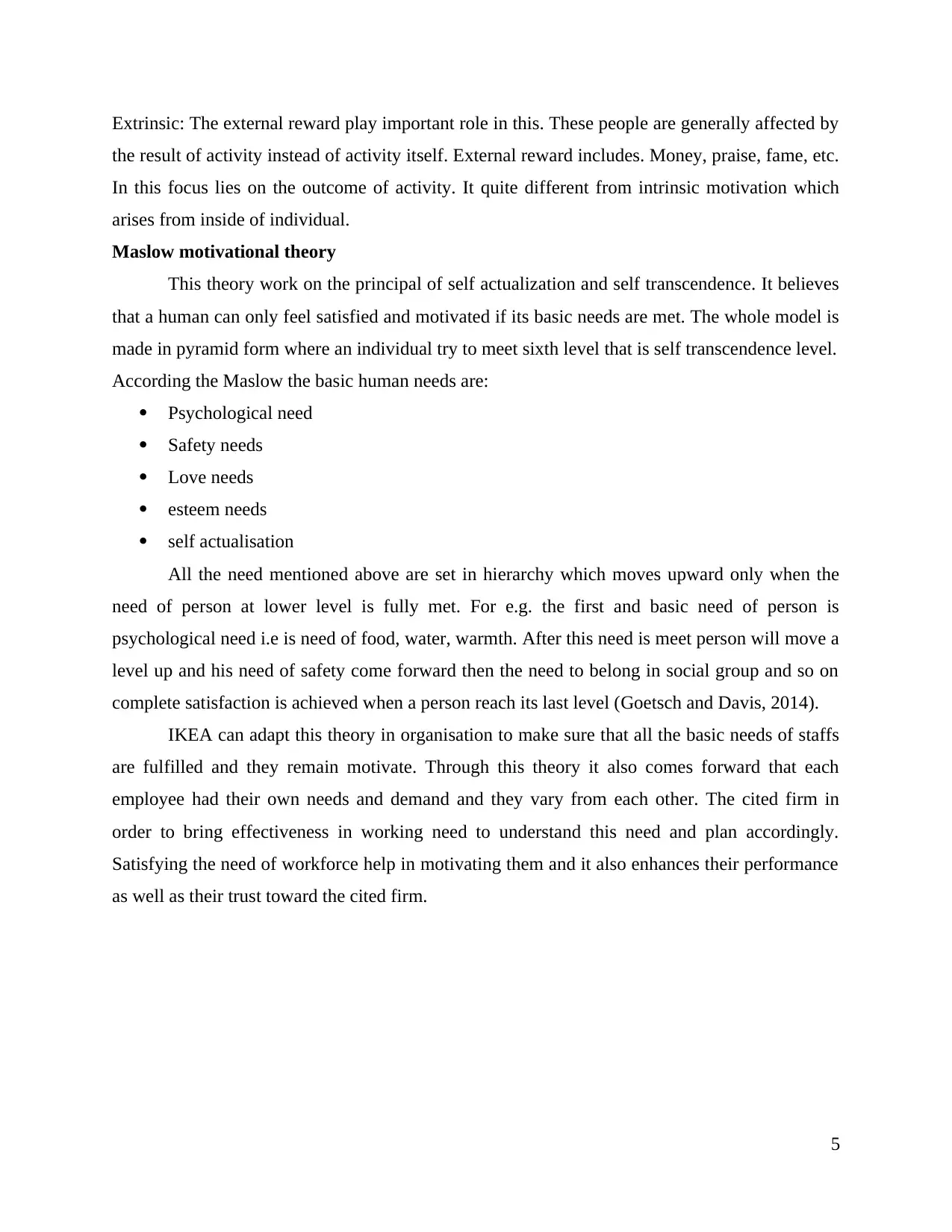
Extrinsic: The external reward play important role in this. These people are generally affected by
the result of activity instead of activity itself. External reward includes. Money, praise, fame, etc.
In this focus lies on the outcome of activity. It quite different from intrinsic motivation which
arises from inside of individual.
Maslow motivational theory
This theory work on the principal of self actualization and self transcendence. It believes
that a human can only feel satisfied and motivated if its basic needs are met. The whole model is
made in pyramid form where an individual try to meet sixth level that is self transcendence level.
According the Maslow the basic human needs are:
Psychological need
Safety needs
Love needs
esteem needs
self actualisation
All the need mentioned above are set in hierarchy which moves upward only when the
need of person at lower level is fully met. For e.g. the first and basic need of person is
psychological need i.e is need of food, water, warmth. After this need is meet person will move a
level up and his need of safety come forward then the need to belong in social group and so on
complete satisfaction is achieved when a person reach its last level (Goetsch and Davis, 2014).
IKEA can adapt this theory in organisation to make sure that all the basic needs of staffs
are fulfilled and they remain motivate. Through this theory it also comes forward that each
employee had their own needs and demand and they vary from each other. The cited firm in
order to bring effectiveness in working need to understand this need and plan accordingly.
Satisfying the need of workforce help in motivating them and it also enhances their performance
as well as their trust toward the cited firm.
5
the result of activity instead of activity itself. External reward includes. Money, praise, fame, etc.
In this focus lies on the outcome of activity. It quite different from intrinsic motivation which
arises from inside of individual.
Maslow motivational theory
This theory work on the principal of self actualization and self transcendence. It believes
that a human can only feel satisfied and motivated if its basic needs are met. The whole model is
made in pyramid form where an individual try to meet sixth level that is self transcendence level.
According the Maslow the basic human needs are:
Psychological need
Safety needs
Love needs
esteem needs
self actualisation
All the need mentioned above are set in hierarchy which moves upward only when the
need of person at lower level is fully met. For e.g. the first and basic need of person is
psychological need i.e is need of food, water, warmth. After this need is meet person will move a
level up and his need of safety come forward then the need to belong in social group and so on
complete satisfaction is achieved when a person reach its last level (Goetsch and Davis, 2014).
IKEA can adapt this theory in organisation to make sure that all the basic needs of staffs
are fulfilled and they remain motivate. Through this theory it also comes forward that each
employee had their own needs and demand and they vary from each other. The cited firm in
order to bring effectiveness in working need to understand this need and plan accordingly.
Satisfying the need of workforce help in motivating them and it also enhances their performance
as well as their trust toward the cited firm.
5
Paraphrase This Document
Need a fresh take? Get an instant paraphrase of this document with our AI Paraphraser
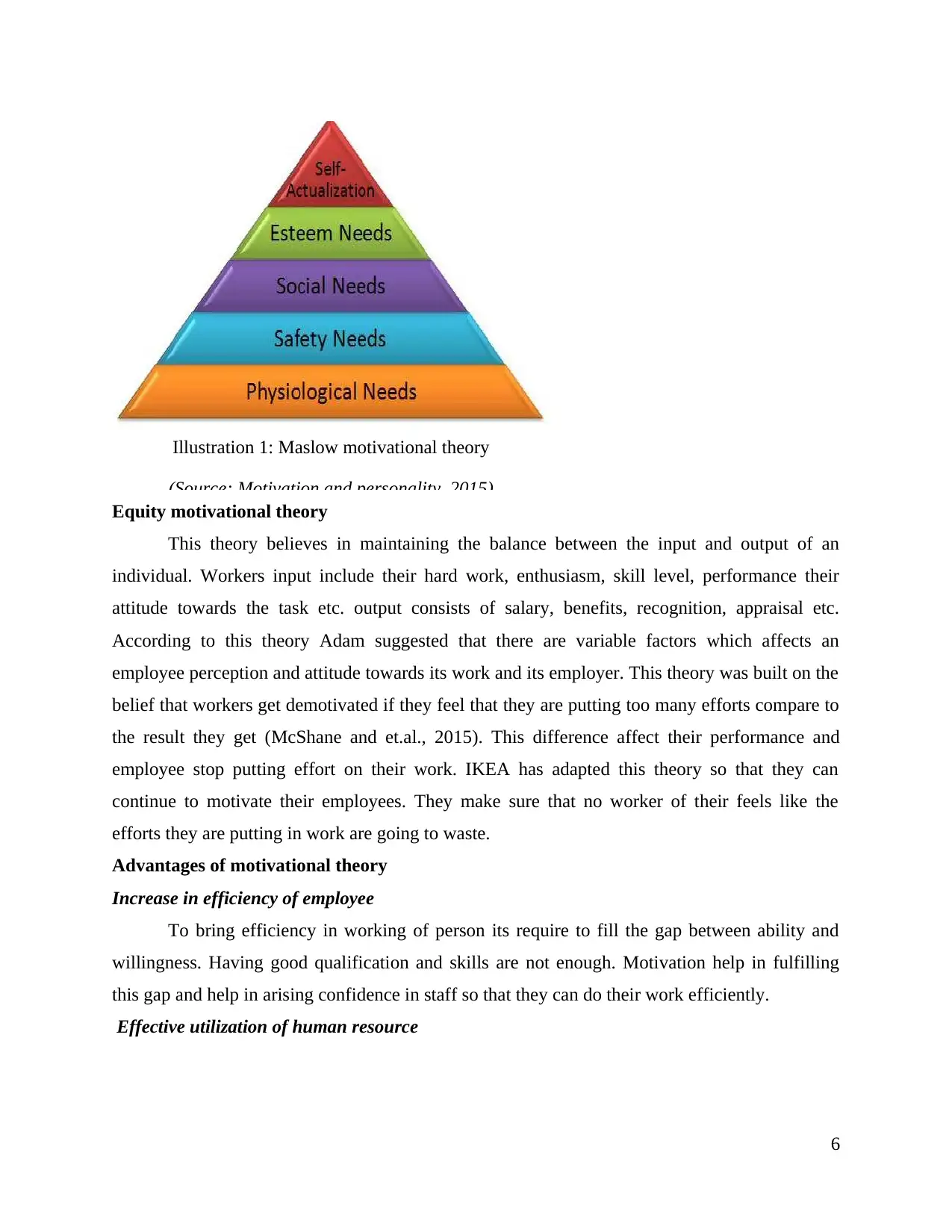
Illustration 1: Maslow motivational theory
(Source: Motivation and personality. 2015)
Equity motivational theory
This theory believes in maintaining the balance between the input and output of an
individual. Workers input include their hard work, enthusiasm, skill level, performance their
attitude towards the task etc. output consists of salary, benefits, recognition, appraisal etc.
According to this theory Adam suggested that there are variable factors which affects an
employee perception and attitude towards its work and its employer. This theory was built on the
belief that workers get demotivated if they feel that they are putting too many efforts compare to
the result they get (McShane and et.al., 2015). This difference affect their performance and
employee stop putting effort on their work. IKEA has adapted this theory so that they can
continue to motivate their employees. They make sure that no worker of their feels like the
efforts they are putting in work are going to waste.
Advantages of motivational theory
Increase in efficiency of employee
To bring efficiency in working of person its require to fill the gap between ability and
willingness. Having good qualification and skills are not enough. Motivation help in fulfilling
this gap and help in arising confidence in staff so that they can do their work efficiently.
Effective utilization of human resource
6
(Source: Motivation and personality. 2015)
Equity motivational theory
This theory believes in maintaining the balance between the input and output of an
individual. Workers input include their hard work, enthusiasm, skill level, performance their
attitude towards the task etc. output consists of salary, benefits, recognition, appraisal etc.
According to this theory Adam suggested that there are variable factors which affects an
employee perception and attitude towards its work and its employer. This theory was built on the
belief that workers get demotivated if they feel that they are putting too many efforts compare to
the result they get (McShane and et.al., 2015). This difference affect their performance and
employee stop putting effort on their work. IKEA has adapted this theory so that they can
continue to motivate their employees. They make sure that no worker of their feels like the
efforts they are putting in work are going to waste.
Advantages of motivational theory
Increase in efficiency of employee
To bring efficiency in working of person its require to fill the gap between ability and
willingness. Having good qualification and skills are not enough. Motivation help in fulfilling
this gap and help in arising confidence in staff so that they can do their work efficiently.
Effective utilization of human resource
6
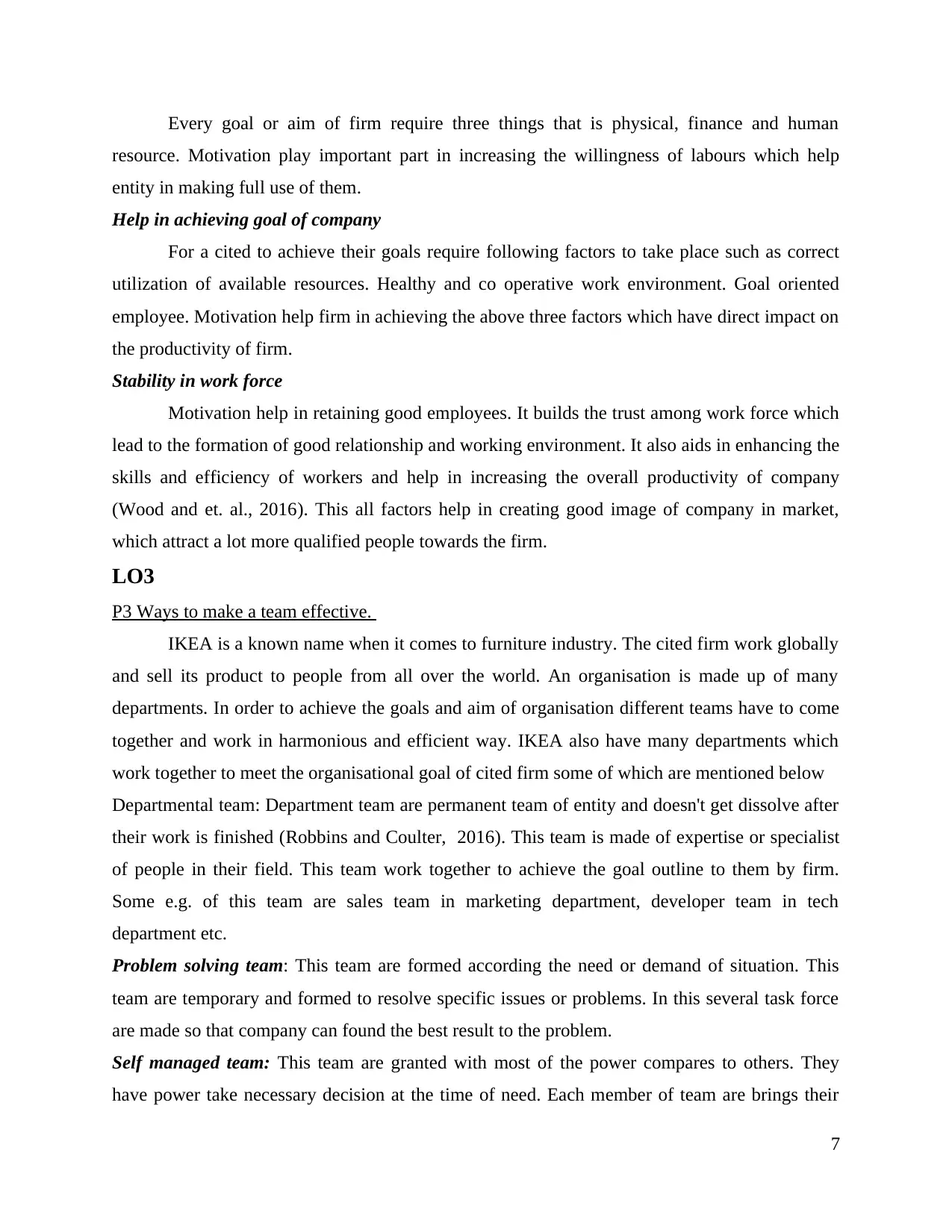
Every goal or aim of firm require three things that is physical, finance and human
resource. Motivation play important part in increasing the willingness of labours which help
entity in making full use of them.
Help in achieving goal of company
For a cited to achieve their goals require following factors to take place such as correct
utilization of available resources. Healthy and co operative work environment. Goal oriented
employee. Motivation help firm in achieving the above three factors which have direct impact on
the productivity of firm.
Stability in work force
Motivation help in retaining good employees. It builds the trust among work force which
lead to the formation of good relationship and working environment. It also aids in enhancing the
skills and efficiency of workers and help in increasing the overall productivity of company
(Wood and et. al., 2016). This all factors help in creating good image of company in market,
which attract a lot more qualified people towards the firm.
LO3
P3 Ways to make a team effective.
IKEA is a known name when it comes to furniture industry. The cited firm work globally
and sell its product to people from all over the world. An organisation is made up of many
departments. In order to achieve the goals and aim of organisation different teams have to come
together and work in harmonious and efficient way. IKEA also have many departments which
work together to meet the organisational goal of cited firm some of which are mentioned below
Departmental team: Department team are permanent team of entity and doesn't get dissolve after
their work is finished (Robbins and Coulter, 2016). This team is made of expertise or specialist
of people in their field. This team work together to achieve the goal outline to them by firm.
Some e.g. of this team are sales team in marketing department, developer team in tech
department etc.
Problem solving team: This team are formed according the need or demand of situation. This
team are temporary and formed to resolve specific issues or problems. In this several task force
are made so that company can found the best result to the problem.
Self managed team: This team are granted with most of the power compares to others. They
have power take necessary decision at the time of need. Each member of team are brings their
7
resource. Motivation play important part in increasing the willingness of labours which help
entity in making full use of them.
Help in achieving goal of company
For a cited to achieve their goals require following factors to take place such as correct
utilization of available resources. Healthy and co operative work environment. Goal oriented
employee. Motivation help firm in achieving the above three factors which have direct impact on
the productivity of firm.
Stability in work force
Motivation help in retaining good employees. It builds the trust among work force which
lead to the formation of good relationship and working environment. It also aids in enhancing the
skills and efficiency of workers and help in increasing the overall productivity of company
(Wood and et. al., 2016). This all factors help in creating good image of company in market,
which attract a lot more qualified people towards the firm.
LO3
P3 Ways to make a team effective.
IKEA is a known name when it comes to furniture industry. The cited firm work globally
and sell its product to people from all over the world. An organisation is made up of many
departments. In order to achieve the goals and aim of organisation different teams have to come
together and work in harmonious and efficient way. IKEA also have many departments which
work together to meet the organisational goal of cited firm some of which are mentioned below
Departmental team: Department team are permanent team of entity and doesn't get dissolve after
their work is finished (Robbins and Coulter, 2016). This team is made of expertise or specialist
of people in their field. This team work together to achieve the goal outline to them by firm.
Some e.g. of this team are sales team in marketing department, developer team in tech
department etc.
Problem solving team: This team are formed according the need or demand of situation. This
team are temporary and formed to resolve specific issues or problems. In this several task force
are made so that company can found the best result to the problem.
Self managed team: This team are granted with most of the power compares to others. They
have power take necessary decision at the time of need. Each member of team are brings their
7
⊘ This is a preview!⊘
Do you want full access?
Subscribe today to unlock all pages.

Trusted by 1+ million students worldwide
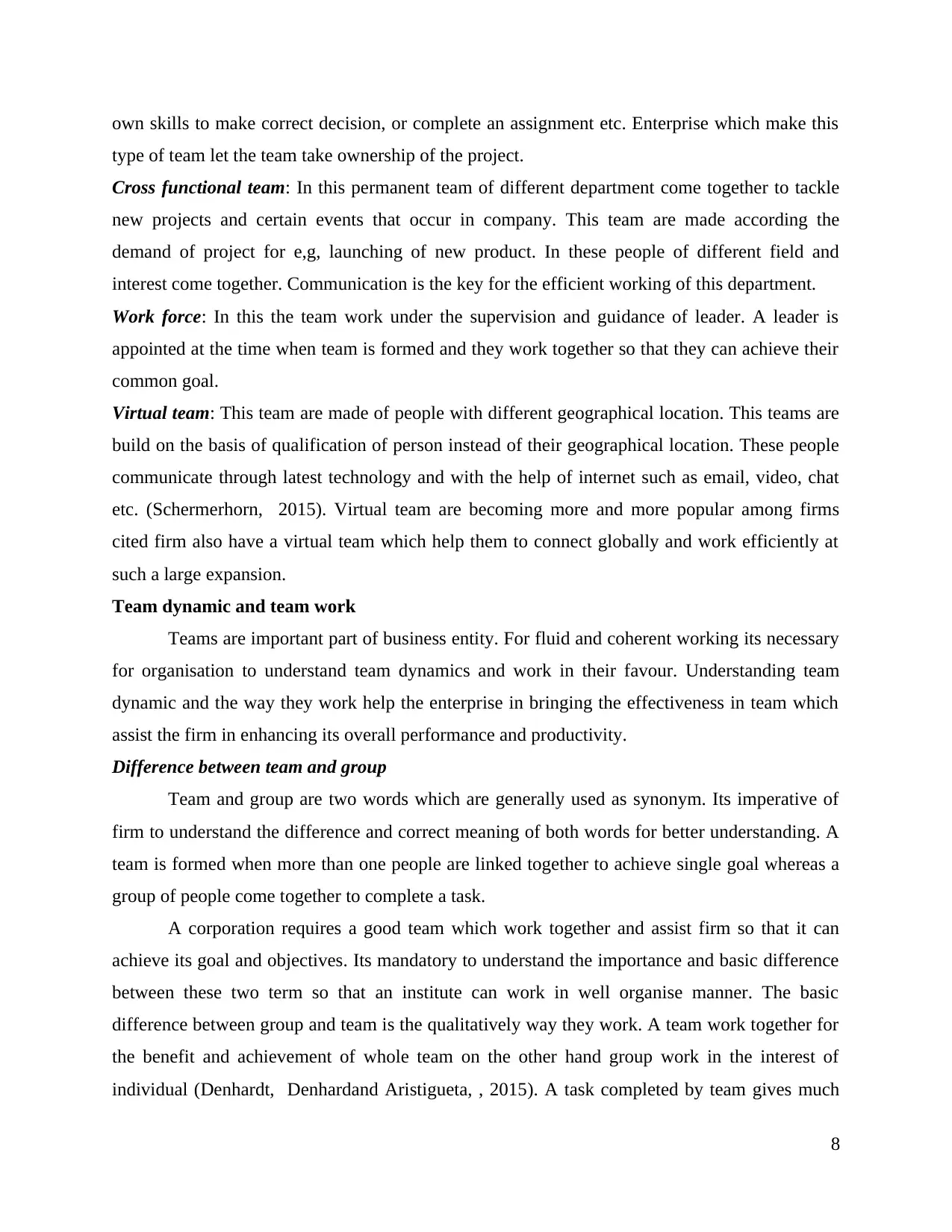
own skills to make correct decision, or complete an assignment etc. Enterprise which make this
type of team let the team take ownership of the project.
Cross functional team: In this permanent team of different department come together to tackle
new projects and certain events that occur in company. This team are made according the
demand of project for e,g, launching of new product. In these people of different field and
interest come together. Communication is the key for the efficient working of this department.
Work force: In this the team work under the supervision and guidance of leader. A leader is
appointed at the time when team is formed and they work together so that they can achieve their
common goal.
Virtual team: This team are made of people with different geographical location. This teams are
build on the basis of qualification of person instead of their geographical location. These people
communicate through latest technology and with the help of internet such as email, video, chat
etc. (Schermerhorn, 2015). Virtual team are becoming more and more popular among firms
cited firm also have a virtual team which help them to connect globally and work efficiently at
such a large expansion.
Team dynamic and team work
Teams are important part of business entity. For fluid and coherent working its necessary
for organisation to understand team dynamics and work in their favour. Understanding team
dynamic and the way they work help the enterprise in bringing the effectiveness in team which
assist the firm in enhancing its overall performance and productivity.
Difference between team and group
Team and group are two words which are generally used as synonym. Its imperative of
firm to understand the difference and correct meaning of both words for better understanding. A
team is formed when more than one people are linked together to achieve single goal whereas a
group of people come together to complete a task.
A corporation requires a good team which work together and assist firm so that it can
achieve its goal and objectives. Its mandatory to understand the importance and basic difference
between these two term so that an institute can work in well organise manner. The basic
difference between group and team is the qualitatively way they work. A team work together for
the benefit and achievement of whole team on the other hand group work in the interest of
individual (Denhardt, Denhardand Aristigueta, , 2015). A task completed by team gives much
8
type of team let the team take ownership of the project.
Cross functional team: In this permanent team of different department come together to tackle
new projects and certain events that occur in company. This team are made according the
demand of project for e,g, launching of new product. In these people of different field and
interest come together. Communication is the key for the efficient working of this department.
Work force: In this the team work under the supervision and guidance of leader. A leader is
appointed at the time when team is formed and they work together so that they can achieve their
common goal.
Virtual team: This team are made of people with different geographical location. This teams are
build on the basis of qualification of person instead of their geographical location. These people
communicate through latest technology and with the help of internet such as email, video, chat
etc. (Schermerhorn, 2015). Virtual team are becoming more and more popular among firms
cited firm also have a virtual team which help them to connect globally and work efficiently at
such a large expansion.
Team dynamic and team work
Teams are important part of business entity. For fluid and coherent working its necessary
for organisation to understand team dynamics and work in their favour. Understanding team
dynamic and the way they work help the enterprise in bringing the effectiveness in team which
assist the firm in enhancing its overall performance and productivity.
Difference between team and group
Team and group are two words which are generally used as synonym. Its imperative of
firm to understand the difference and correct meaning of both words for better understanding. A
team is formed when more than one people are linked together to achieve single goal whereas a
group of people come together to complete a task.
A corporation requires a good team which work together and assist firm so that it can
achieve its goal and objectives. Its mandatory to understand the importance and basic difference
between these two term so that an institute can work in well organise manner. The basic
difference between group and team is the qualitatively way they work. A team work together for
the benefit and achievement of whole team on the other hand group work in the interest of
individual (Denhardt, Denhardand Aristigueta, , 2015). A task completed by team gives much
8
Paraphrase This Document
Need a fresh take? Get an instant paraphrase of this document with our AI Paraphraser
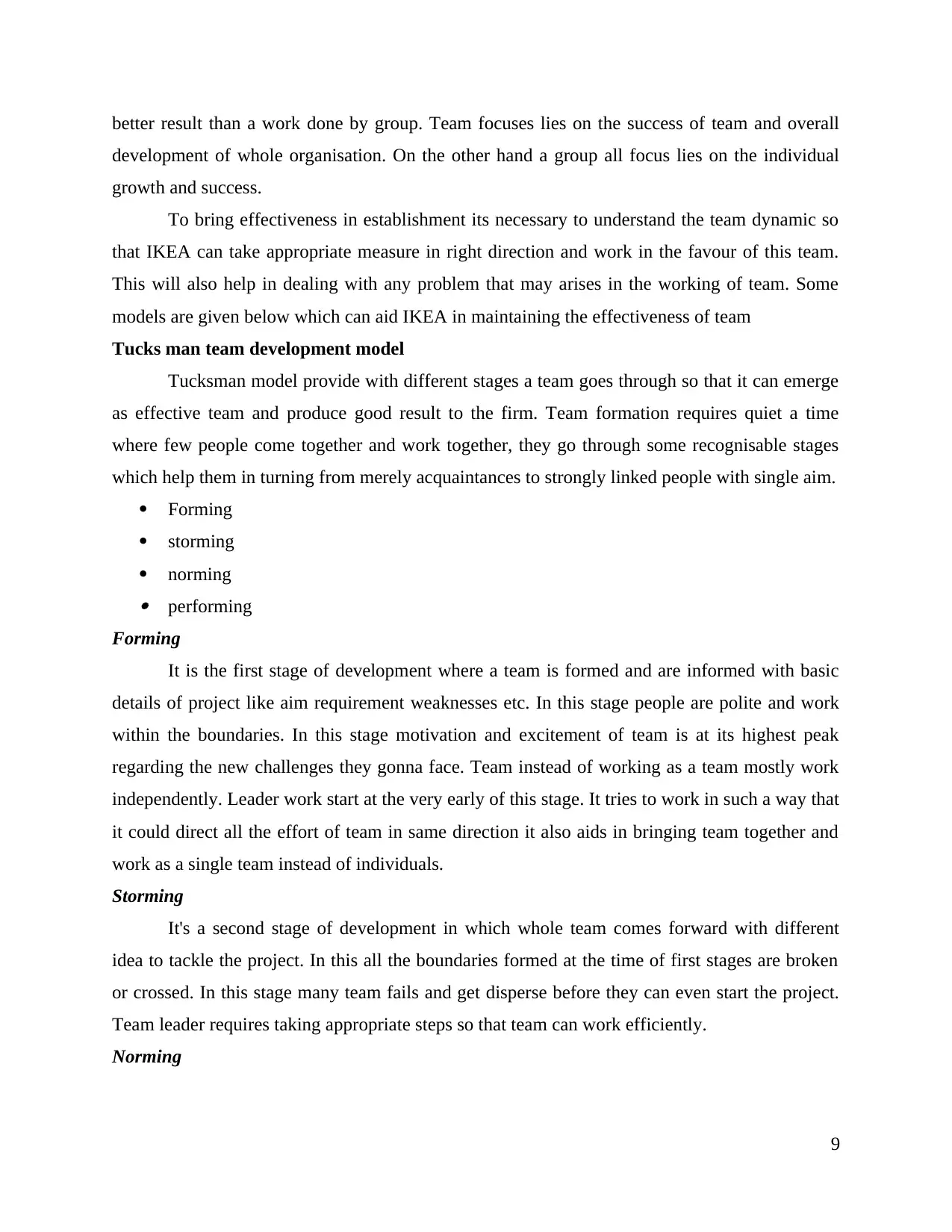
better result than a work done by group. Team focuses lies on the success of team and overall
development of whole organisation. On the other hand a group all focus lies on the individual
growth and success.
To bring effectiveness in establishment its necessary to understand the team dynamic so
that IKEA can take appropriate measure in right direction and work in the favour of this team.
This will also help in dealing with any problem that may arises in the working of team. Some
models are given below which can aid IKEA in maintaining the effectiveness of team
Tucks man team development model
Tucksman model provide with different stages a team goes through so that it can emerge
as effective team and produce good result to the firm. Team formation requires quiet a time
where few people come together and work together, they go through some recognisable stages
which help them in turning from merely acquaintances to strongly linked people with single aim.
Forming
storming
norming performing
Forming
It is the first stage of development where a team is formed and are informed with basic
details of project like aim requirement weaknesses etc. In this stage people are polite and work
within the boundaries. In this stage motivation and excitement of team is at its highest peak
regarding the new challenges they gonna face. Team instead of working as a team mostly work
independently. Leader work start at the very early of this stage. It tries to work in such a way that
it could direct all the effort of team in same direction it also aids in bringing team together and
work as a single team instead of individuals.
Storming
It's a second stage of development in which whole team comes forward with different
idea to tackle the project. In this all the boundaries formed at the time of first stages are broken
or crossed. In this stage many team fails and get disperse before they can even start the project.
Team leader requires taking appropriate steps so that team can work efficiently.
Norming
9
development of whole organisation. On the other hand a group all focus lies on the individual
growth and success.
To bring effectiveness in establishment its necessary to understand the team dynamic so
that IKEA can take appropriate measure in right direction and work in the favour of this team.
This will also help in dealing with any problem that may arises in the working of team. Some
models are given below which can aid IKEA in maintaining the effectiveness of team
Tucks man team development model
Tucksman model provide with different stages a team goes through so that it can emerge
as effective team and produce good result to the firm. Team formation requires quiet a time
where few people come together and work together, they go through some recognisable stages
which help them in turning from merely acquaintances to strongly linked people with single aim.
Forming
storming
norming performing
Forming
It is the first stage of development where a team is formed and are informed with basic
details of project like aim requirement weaknesses etc. In this stage people are polite and work
within the boundaries. In this stage motivation and excitement of team is at its highest peak
regarding the new challenges they gonna face. Team instead of working as a team mostly work
independently. Leader work start at the very early of this stage. It tries to work in such a way that
it could direct all the effort of team in same direction it also aids in bringing team together and
work as a single team instead of individuals.
Storming
It's a second stage of development in which whole team comes forward with different
idea to tackle the project. In this all the boundaries formed at the time of first stages are broken
or crossed. In this stage many team fails and get disperse before they can even start the project.
Team leader requires taking appropriate steps so that team can work efficiently.
Norming
9
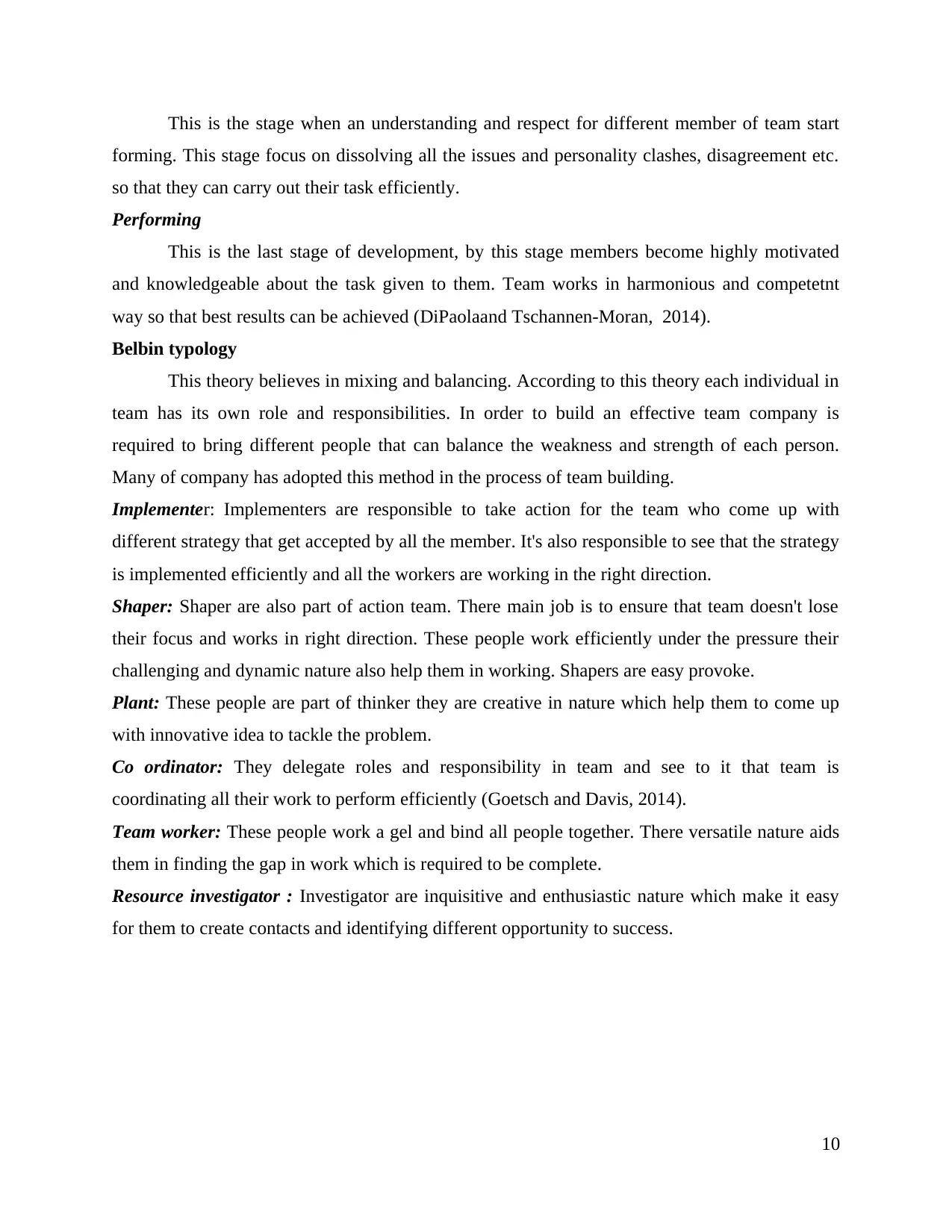
This is the stage when an understanding and respect for different member of team start
forming. This stage focus on dissolving all the issues and personality clashes, disagreement etc.
so that they can carry out their task efficiently.
Performing
This is the last stage of development, by this stage members become highly motivated
and knowledgeable about the task given to them. Team works in harmonious and competetnt
way so that best results can be achieved (DiPaolaand Tschannen-Moran, 2014).
Belbin typology
This theory believes in mixing and balancing. According to this theory each individual in
team has its own role and responsibilities. In order to build an effective team company is
required to bring different people that can balance the weakness and strength of each person.
Many of company has adopted this method in the process of team building.
Implementer: Implementers are responsible to take action for the team who come up with
different strategy that get accepted by all the member. It's also responsible to see that the strategy
is implemented efficiently and all the workers are working in the right direction.
Shaper: Shaper are also part of action team. There main job is to ensure that team doesn't lose
their focus and works in right direction. These people work efficiently under the pressure their
challenging and dynamic nature also help them in working. Shapers are easy provoke.
Plant: These people are part of thinker they are creative in nature which help them to come up
with innovative idea to tackle the problem.
Co ordinator: They delegate roles and responsibility in team and see to it that team is
coordinating all their work to perform efficiently (Goetsch and Davis, 2014).
Team worker: These people work a gel and bind all people together. There versatile nature aids
them in finding the gap in work which is required to be complete.
Resource investigator : Investigator are inquisitive and enthusiastic nature which make it easy
for them to create contacts and identifying different opportunity to success.
10
forming. This stage focus on dissolving all the issues and personality clashes, disagreement etc.
so that they can carry out their task efficiently.
Performing
This is the last stage of development, by this stage members become highly motivated
and knowledgeable about the task given to them. Team works in harmonious and competetnt
way so that best results can be achieved (DiPaolaand Tschannen-Moran, 2014).
Belbin typology
This theory believes in mixing and balancing. According to this theory each individual in
team has its own role and responsibilities. In order to build an effective team company is
required to bring different people that can balance the weakness and strength of each person.
Many of company has adopted this method in the process of team building.
Implementer: Implementers are responsible to take action for the team who come up with
different strategy that get accepted by all the member. It's also responsible to see that the strategy
is implemented efficiently and all the workers are working in the right direction.
Shaper: Shaper are also part of action team. There main job is to ensure that team doesn't lose
their focus and works in right direction. These people work efficiently under the pressure their
challenging and dynamic nature also help them in working. Shapers are easy provoke.
Plant: These people are part of thinker they are creative in nature which help them to come up
with innovative idea to tackle the problem.
Co ordinator: They delegate roles and responsibility in team and see to it that team is
coordinating all their work to perform efficiently (Goetsch and Davis, 2014).
Team worker: These people work a gel and bind all people together. There versatile nature aids
them in finding the gap in work which is required to be complete.
Resource investigator : Investigator are inquisitive and enthusiastic nature which make it easy
for them to create contacts and identifying different opportunity to success.
10
⊘ This is a preview!⊘
Do you want full access?
Subscribe today to unlock all pages.

Trusted by 1+ million students worldwide
1 out of 17
Related Documents
Your All-in-One AI-Powered Toolkit for Academic Success.
+13062052269
info@desklib.com
Available 24*7 on WhatsApp / Email
![[object Object]](/_next/static/media/star-bottom.7253800d.svg)
Unlock your academic potential
Copyright © 2020–2025 A2Z Services. All Rights Reserved. Developed and managed by ZUCOL.





